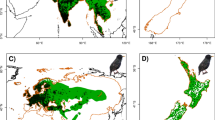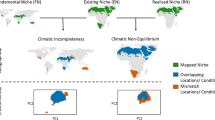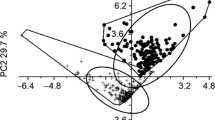Abstract
Invasive species are known to influence the structure and function of invaded ecological communities, and preventive measures appear to be the most efficient means of controlling these effects. However, management of biological invasions requires use of adequate tools to understand and predict invasion patterns in recently introduced areas. The present study: (1) estimates the potential geographic distribution and ecological requirements of the Argentine ant (Linepithema humile Mayr), one of the most conspicuous invasive species throughout the world, in the Iberian Peninsula using ecological niche modeling, and (2) provides new insights into the process of selection of consensual areas among predictions from several modeling methodologies. Ecological niche models were developed using 5 modeling techniques: generalized linear models (GLM), generalized additive models (GAM), generalized boosted models (GBM), Genetic Algorithm for Rule-Set Prediction (GARP), and Maximum Entropy (Maxent). Models for the eastern and western portions of the Iberian Peninsula were built using subsets of occurrence and environmental data to investigate the potential for ecological niche differences between the invading populations. Our results indicate geographic differences between predictions of different approaches, and the utility of ensemble predictions in identifying areas of uncertainty regarding the species’ invasive potential. More generally, our models predict coastal areas and major river corridors as highly suitable for Argentine ants, and indicate that western and eastern Iberian Peninsula populations occupy similar environmental conditions.






Similar content being viewed by others
References
Abril S (2005) Ecologia alimentària de la formiga argentina (Linepithema humile) en ecosistemes naturals: activitat d’extracció de melassa de Quercus suber i dieta sòlida. Universitat de Girona, Dissertation
Akaike H (1974) A new look at the statistical model identification. IEEE Trans Automat Contr 19:716–723. doi:10.1109/TAC.1974.1100705
Anderson RP, Lew D, Peterson AT (2003) Evaluating predictive models of species’ distributions: criteria for selecting optimal models. Ecol Model 162:211–232. doi:10.1016/S0304-3800(02)00349-6
Araújo MB, Guisan A (2006) Five (or so) challenges for species distribution modelling. J Biogeogr 33:1677–1688. doi:10.1111/j.1365-2699.2006.01584.x
Araújo MB, New M (2007) Ensemble forecasting of species distributions. Trends Ecol Evol 22:42–47. doi:10.1016/j.tree.2006.09.010
Araújo MB, Thuiller W, Pearson RG (2006) Climate warming and the decline of amphibians and reptiles in Europe. J Biogeogr 33:1712–1728. doi:10.1111/j.1365-2699.2006.01482.x
Breiman L, Friedman JH, Olshen RA et al (1984) Classification and regression trees. Chapman and Hall, New York
Broennimann O, Treier UA, Muller-Scharer H et al (2007) Evidence of climatic niche shift during biological invasion. Ecol Lett 10:701–709. doi:10.1111/j.1461-0248.2007.01060.x
Brotons L, Thuiller W, Araújo MB et al (2004) Presence-absence versus presence-only modelling methods for predicting bird habitat suitability. Ecography 27:437–448. doi:10.1111/j.0906-7590.2004.03764.x
Carpintero S, Reyes-López J (2008) The role of competitive dominance in the invasive ability of the Argentine ant (Linepithema humile). Biol Invasions 10:25–35
Carpintero S, Reyes-López J, Arias de Reyna L (2004) Impact of human dwellings on the distribution of the exotic Argentine ant: a case study in the Doñana National Park, Spain. Biol Conserv 115:279–289. doi:10.1016/S0006-3207(03)00147-2
Carpintero S, Reyes-López J, Arias de Reyna L (2005) Impact of Argentine ants (Linepithema humile) on an arboreal ant community in Doñana National Park, Spain. Biodivers Conserv 14:151–163. doi:10.1007/s10531-005-3947-6
Casellas D (2004) Tasa de expansión de la hormiga argentina, Linepithema humile (Mayr 1868), (Hymenoptera, Dolichoderine) en un área mediterránea. Bol Asoc Esp Entomol 28:207–216
Chapin FSI, Zavaleta ES, Eviner VT et al (2000) Consequences of changing biodiversity. Nature 405:234–242. doi:10.1038/35012241
Drake JM, Lodge DM (2006) Forecasting potential distributions of nonindigenous species with a genetic algorithm. Fisheries 31:9–16. doi:10.1577/1548-8446(2006)31[9:FPDONS]2.0.CO;2
Elith J, Graham CH, Anderson RP et al (2006) Novel methods improve prediction of species’ distributions from occurrence data. Ecography 29:129–151. doi:10.1111/j.2006.0906-7590.04596.x
Elith J, Leathwick JR, Hastie T (2008) A working guide to boosted regression trees. J Anim Ecol 77:802–813. doi:10.1111/j.1365-2656.2008.01390.x
Espadaler X, Gómez C (2003) The Argentine ant, Linepithema humile, in the Iberian Peninsula. Sociobiology 42:187–192
Farina A, Bogaert J, Schipani I (2005) Cognitive landscape and information: new perspectives to investigate the ecological complexity. Biosystems 79:235–240. doi:10.1016/j.biosystems.2004.09.018
Friedman JH (2001) Greedy function approximation: A gradient boosting machine. Ann Stat 29:1189–1232. doi:10.1214/aos/1013203451
Friedman JH, Meulman JJ (2003) Multiple additive regression trees with application in epidemiology. Stat Med 22:1365–1381
Giraud T, Pedersen JS, Keller L (2002) Evolution of supercolonies: the Argentine ants of southern Europe. Proc Natl Acad Sci USA 99:6075–6079. doi:10.1073/pnas.092694199
Grinnell J (1917) Field tests of theories concerning distributional control. Am Nat 51:115–128. doi:10.1086/279591
Guisan A, Thuiller W (2005) Predicting species distribution: offering more than simple habitat models. Ecol Lett 8:993–1009. doi:10.1111/j.1461-0248.2005.00792.x
Guisan A, Edwards TC, Hastie T (2002) Generalized linear and generalized additive models in studies of species distributions: setting the scene. Ecol Model 157:89–100. doi:10.1016/S0304-3800(02)00204-1
Hanley JA, McNeil BJ (1982) The meaning and use of the area under a receiver operating characteristic (ROC) Curve. Radiology 143:29–36
Hartley S, Lester PJ (2003) Temperature-dependent development of the Argentine ant, Linepithema humile (Mayr) (Hymenoptera: Formicidae): a degree-day model with implications for range limits in New Zealand. NZ Entomol 26:91–100
Hartley S, Harris R, Lester PJ (2006) Quantifying uncertainty in the potential distribution of an invasive species: climate and the Argentine ant. Ecol Lett 9:1068–1079. doi:10.1111/j.1461-0248.2006.00954.x
Hastie TJ, Tibshirani RJ (1990) Generalized additive models. Chapman & Hall, London
Hee JJ, Holway DA, Suarez AV et al (2000) Role of propagule size in the success of incipient colonies of the invasive Argentine ant. Conserv Biol 14:559–563. doi:10.1046/j.1523-1739.2000.99040.x
Heller NE, Sanders NJ, Gordon DM (2006) Linking temporal and spatial scales in the study of an Argentine ant invasion. Biol Invasions 8:501–507. doi:10.1007/s10530-005-6411-3
Heller NE, Sanders NJ, Shors JW et al (2008) Rainfall facilitates the spread, and time alters the impact, of the invasive Argentine ant. Oecologia 155:385–395. doi:10.1007/s00442-007-0911-z
Holway DA (1995) Distribution of the Argentine ant (Linepithema humile) in Northern California. Conserv Biol 9:1634–1637. doi:10.1046/j.1523-1739.1995.09061634.x
Holway DA (1998) Factors governing rate of invasion: a natural experiment using Argentine ants. Oecologia 115:206–212. doi:10.1007/s004420050509
Holway DA, Suarez AV, Case TJ (2002) Role of abiotic factors in governing susceptibility to invasion: a test with Argentine ants. Ecology 83:1610–1619
Huete A, Didan K, Miura R et al (2002) Overview of the radiometric and biophysical performance of the MODIS vegetation indices. Remote Sens Environ 83:195–213. doi:10.1016/S0034-4257(02)00096-2
Human KG, Weiss S, Weiss A et al (1998) Effects of abiotic factors on the distribution and activity of the invasive Argentine ant (Hymenoptera: Formicidae). Environ Entomol 27:822–833
Hutchinson GE (1957) A treatise on limnology. Wiley, New York
Justice C, Vermote E, Townshend JRG et al (1998) The moderate resolution imaging spectroradiometer (MODIS): land remote sensing for global change research. IEEE Trans Geosci Rem Sens 36:1228–1249. doi:10.1109/36.701075
Krushelnycky PD, Joe SM, Medeiros AC et al (2005) The role of abiotic conditions in shaping the long-term patterns of a high-elevation Argentine ant invasion. Divers Distrib 11:319–331. doi:10.1111/j.1366-9516.2005.00151.x
Leathwick JR, Elith J, Francis MP et al (2006) Variation in demersal fish species richness in the oceans surrounding New Zealand: an analysis using boosted regression trees. Mar Ecol Prog Ser 321:267–281. doi:10.3354/meps321267
Mack MC, Simberloff D, Lonsdale WM et al (2000) Biotic invasions: causes, epidemiology, global consequences, and control. Ecol Appl 10:689–710. doi:10.1890/1051-0761(2000)010[0689:BICEGC]2.0.CO;2
Mackey BG, Lindenmayer DB (2001) Towards a hierarchical framework for modelling the spatial distribution of animals. J Biogeogr 28:1147–1166. doi:10.1046/j.1365-2699.2001.00626.x
Manel S, Williams HC, Ormerod SJ (2001) Evaluating presence-absence models in ecology: the need to account for prevalence. J Appl Ecol 38:921–931. doi:10.1046/j.1365-2664.2001.00647.x
Menke SB, Holway DA (2006) Abiotic factors control invasion by Argentine ants at the community scale. J Anim Ecol 75:368–376. doi:10.1111/j.1365-2656.2006.01056.x
Menke SB, Fisher RN, Jetz W et al (2007) Biotic and abiotic controls of Argentine ant invasion success at local and landscape scales. Ecology 88:3164–3173. doi:10.1890/07-0122.1
Ninyerola M, Pons X, Roure JM (2005) Atlas climático digital de la Península Ibérica: metodología y aplicaciones en bioclimatología y geobotánica. Universidad Autónoma de Barcelona
Passera L (1994) Characteristics of tramp species. In: Williams DF (ed) Exotic ants. Biology, impact, and control of introduced species. Westview Press, Boulder
Pearce JL, Boyce MS (2006) Modelling distribution and abundance with presence-only data. J Appl Ecol 43:405–412. doi:10.1111/j.1365-2664.2005.01112.x
Pearce J, Ferrier S (2000) Evaluating the predictive performance of habitat models developed using logistic regression. Ecol Model 133:225–245. doi:10.1016/S0304-3800(00)00322-7
Pearson RG, Thuiller W, Araújo MB et al (2006) Model-based uncertainty in species range prediction. J Biogeogr 33:1704–1711. doi:10.1111/j.1365-2699.2006.01460.x
Peterson AT (2003) Predicting the geography of species’ invasions via ecological niche modeling. Q Rev Biol 78:21–35. doi:10.1086/378926
Peterson AT, Cohoon KP (1999) Sensitivity of distributional prediction algorithms to geographic data completeness. Ecol Model 117:159–164. doi:10.1016/S0304-3800(99)00023-X
Peterson AT, Soberón J, Sánchez-Cordero V (1999) Conservatism of ecological niches in evolutionary time. Science 285:1265–1267. doi:10.1126/science.285.5431.1265
Peterson AT, Papeş M, Soberón J (2008) Rethinking receiver operating characteristic analysis applications in ecological niche modelling. Ecol Model 213:63–72
Phillips SJ, Dudík M, Schapire RE (2004) A maximum entropy approach to species distribution modeling. In: Proceedings of the 21st international conference on machine learning, Banff, Canada, pp 655–662
Phillips SJ, Anderson RP, Schapire RE (2006) Maximum entropy modeling of species geographic distributions. Ecol Model 190:231–259. doi:10.1016/j.ecolmodel.2005.03.026
Ridgeway G (1999) The state of boosting. Comput Sci Stat 31:172–181
Rouget M, Richardson DM, Lavorel S et al (2001) Determinants of distribution of six Pinus species in Catalonia, Spain. J Veg Sci 12:491–502. doi:10.2307/3237001
Roura-Pascual N, Suarez AV, Gómez C et al (2004) Geographical potential of Argentine ants (Linepithema humile Mayr) in the face of global climate change. Proc R Soc Lond B Biol Sci 271:2527–2535. doi:10.1098/rspb.2004.2898
Roura-Pascual N, Suarez AV, McNyset K et al (2006) Niche differentiation and fine-scale projections for Argentine ants based on remotely sensed data. Ecol Appl 16:1832–1841. doi:10.1890/1051-0761(2006)016[1832:NDAFPF]2.0.CO;2
Rushton SP, Ormerod SJ, Kerby G (2004) New paradigms for modelling species distributions? J Appl Ecol 41:193–200. doi:10.1111/j.0021-8901.2004.00903.x
Soberón J, Peterson AT (2005) Interpretation of models of fundamental ecological niches and species’ distributional areas. Biodivers Inform 2:1–10
Stockwell DRB, Noble IR (1992) Induction of sets of rules from animal distribution data: a robust and informative method of data analysis. Math Comput Simul 33:385–390. doi:10.1016/0378-4754(92)90126-2
Stockwell DRB, Peters D (1999) The GARP modelling system: problems and solutions to automated spatial prediction. Int J Geogr Inf Sci 13:143–158. doi:10.1080/136588199241391
Stockwell DRB, Peterson AT (2002) Controlling bias in biodiversity data. In: Scott JM, Heglund PJ, Morrison ML et al (eds) Predicting species occurrences: issues of accuracy and scale. Island Press, Washington, pp 537–546
Suarez AV, Holway DA, Case TJ (2001) Patterns of spread in biological invasions dominated by long-distance jump dispersal: insights from Argentine ants. Proc Natl Acad Sci USA 98:1095–1100. doi:10.1073/pnas.98.3.1095
Thuiller W (2003) BIOMOD – optimizing predictions of species distributions and projecting potential future shifts under global change. Glob Change Biol 9:1353–1362. doi:10.1046/j.1365-2486.2003.00666.x
Thuiller W (2004) Patterns and uncertainties of species’ range shifts under climate change. Glob Change Biol 10:2020–2027. doi:10.1111/j.1365-2486.2004.00859.x
Thuiller W, Vayreda J, Pino J et al (2003) Large-scale environmental correlates of forest tree distributions in Catalonia (NE Spain). Glob Ecol Biogeogr 12:313–325. doi:10.1046/j.1466-822X.2003.00033.x
Thuiller W, Brotons L, Araújo MB et al (2004) Effects of restricting environmental range of data to project current and future species distributions. Ecography 27:165–172. doi:10.1111/j.0906-7590.2004.03673.x
Thuiller W, Midgley GF, Rouget M et al (2006) Predicting patterns of plant species richness in megadiverse South Africa. Ecography 29:733–744. doi:10.1111/j.0906-7590.2006.04674.x
Tsutsui ND, Suarez AV, Holway DA et al (2001) Relationships among native and introduced populations of the Argentine ant (Linepithema humile) and the source of introduced populations. Mol Ecol 10:2151–2161. doi:10.1046/j.0962-1083.2001.01363.x
Van Horne B (2002) Approaches to habitat modeling: the tensions between pattern and process and between specificity and generality. In: Scott JM, Heglund, PJ, Morrison ML et al (eds) Predicting species occurrences: issues of accuracy and scale. Island Press, Washington, pp 63–72
Vega SJ, Rust MK (2001) The Argentine ant – a significant invasive species in agricultural, urban and natural environments. Sociobiology 37:3–25
Vitousek PM, D’Antonio CM, Loope LL et al (1997) Introduced species: a significant component of human-caused global change. N Z J Ecol 21:1–16
Ward DF (2007) Modelling the potential geographic distribution of invasive ant species in New Zealand. Biol Invasions 9:723–735. doi:10.1007/s10530-006-9072-y
Ward DF, Harris RJ, Stanley MC (2005) Human-mediated range expansion of Argentine ants Linepithema humile (Hymenoptera: Formicidae) in New Zealand. Sociobiology 45:401–407
Way MJ, Cammell ME, Paiva MR et al (1997) Distribution and dynamics of the Argentine ant Linepithema (Iridomyrmex) humile (Mayr) in relation to vegetation, soil conditions, topography and native competitor ants in Portugal. Insect Soc 44:415–433
Welk E (2004) Constraints in range predictions of invasive plant species due to non-equilibrium distribution patterns: purple loosestrife (Lythrum salicaria) in North America. Ecol Model 179:551–567. doi:10.1016/j.ecolmodel.2004.04.020
Wiens JA (1989) Spatial scaling in ecology. Funct Ecol 3:385–397. doi:10.2307/2389612
Wild AL (2004) Taxonomy and distribution of the Argentine ant, Linepithema humile (Hymenoptera: Formicidae). Ann Entomol Soc Am 97:1204–1215. doi:10.1603/0013-8746(2004)097[1204:TADOTA]2.0.CO;2
Acknowledgments
Special thanks to P. Pons, C. Gómez and E. Knox-Davis for their comments on the manuscript, and M. Clavero, S. Phillips, and J. Hortal for statistical guidance. X. Espadaler provided useful comments on historical data of the Argentine ant invasion in the Iberian Peninsula. This research was funded by the Ministry of Education and Science CGL2004-05240-C02-02/BOS and MEC/FEDER2007-64080-C02-02/BOS of the Spanish Government in support of N. Roura-Pascual, and is a contribution to the European Research Group GDRE “Mediterranean and mountain systems in a changing world”. N. Roura-Pascual benefited from a Beatriu de Pinós postdoctoral grant (2006 BP-A 10124) from Catalan Agency for Management of University and Research Grants, and L. Brotons from a Ramon y Cajal contract from the Spanish government. W. Thuiller was partly funded by the EU FP6 MACIS specific targeted project (Minimisation of and Adaptation to Climate change: Impacts on biodiversity N° 044399) and EU FP6 ECOCHANGE integrated project (Challenges in assessing and forecasting biodiversity and ecosystem changes in Europe).
Author information
Authors and Affiliations
Corresponding author
Rights and permissions
About this article
Cite this article
Roura-Pascual, N., Brotons, L., Peterson, A.T. et al. Consensual predictions of potential distributional areas for invasive species: a case study of Argentine ants in the Iberian Peninsula. Biol Invasions 11, 1017–1031 (2009). https://doi.org/10.1007/s10530-008-9313-3
Received:
Accepted:
Published:
Issue Date:
DOI: https://doi.org/10.1007/s10530-008-9313-3




